by Clare Charlesworth | September 5, 2018
September 4, 2018
Live Blogging an American Football Game

Live Blogging an American Football Game
Live blogging American football games has become increasingly popular, with many regional news outlets live blogging the games throughout the season and several larger international outlets having a go at live blogging the Super Bowl to meet the growing demand for online coverage from an international audience.
Live blogs can be perfect for many different types of football fans who want to keep up to date; the varied post types, such as the play-by-play commentary feature, offer detailed information that could come in handy for fans who are into Fantasy Football, while the different ways of organising a live blog can be helpful for readers who might want to filter your blog so that they read only the game’s highlights. All of this, and much more, make live blogs an ideal medium for covering a football game. So put on your favourite team’s jersey and read on to learn more tips on how to make your live coverage of the next big game clear, entertaining and informative for your readers.
Keeping score
Obviously, keeping track of the score is paramount to covering any sporting event. Live Blog’s scorecard allows for the score to be clearly presented, and its additional features also allow for more detailed information on the score to be included. Many of your readers might appreciate the teams’ overall record so far in the season, and a breakdown of the score for each quarter – this information can be added in the ‘Halftime Results’ editor box and can be easily updated as the game progresses.
Clearly present the game’s score to your audience.

Clearly present the game’s score to your audience.
The scorecard feature also allows for a background image and images representing the different teams to be included. If your coverage has a sponsor and you’re looking for a way to showcase them on your blog, you may want to consider using the background image as a place to promote their product or brand.
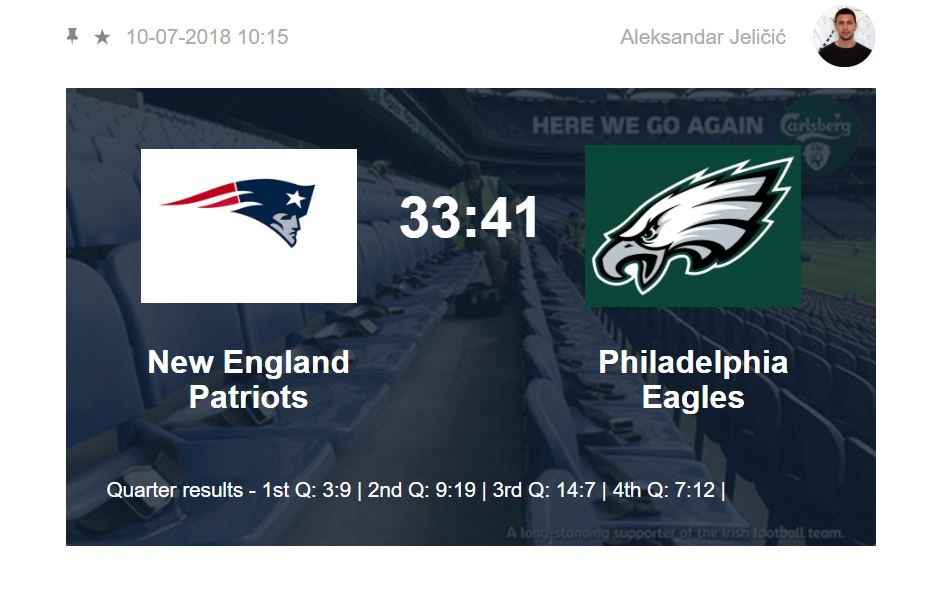
Use the scorecard’s background image as a place to showcase your sponsor.
Shake up your coverage
As we’ve banged on about in previous blog posts, a live blog solely consisting of text risks readers glossing over important information and, often, leaving for more dynamic coverage being offered elsewhere. Images, videos and social media posts can all help to break up large chunks of text and make your coverage more interesting.
Additionally, make the most of Live Blog’s custom post types when displaying game data. Reporting on the time of possession between the two teams just in text probably won’t make as much of an impact as displaying it in a chart or percentage might, using Live Blog’s Statistics in Charts and Statistics in Percentages post types, which can be found on our GitHub, ready to be copied and pasted into Live Blog’s Free Types Manager. Potential statistics to represent in visual form could include time of possession, number of 1st downs, passing yardage, yards per play and turnovers.
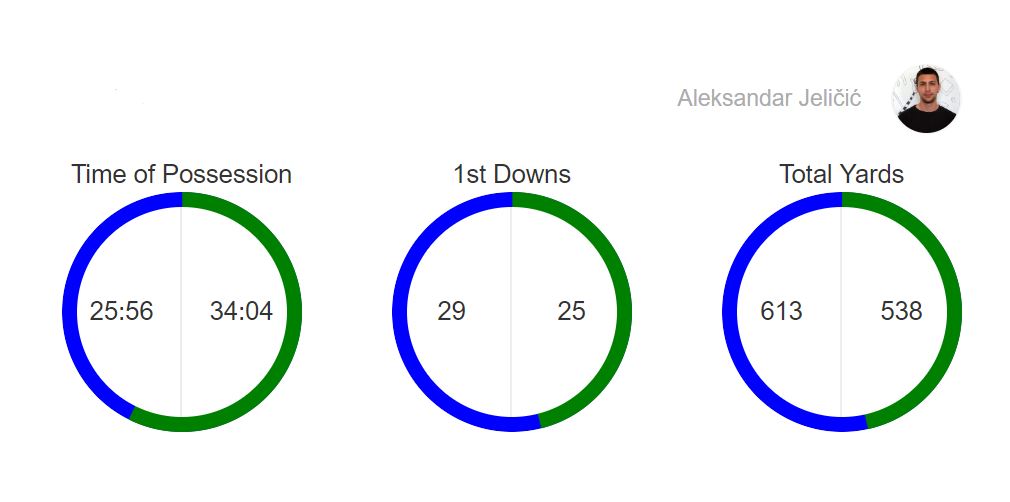
Display important game stats with Live Blog’s custom post types.
If you’d like for your live blog to provide readers with an extremely detailed account of the game, consider using Live Blog’s play-by-play commentary post type, which can also be found on our GitHub. With an easy template/form for you to fill out, consisting of the minute the action took place and a box for a textual description, readers can be kept well-informed on the intricacies of the game. The play-by-play commentary feature can be great to use if you think that some of your readers might be in a fantasy football league, as they’ll want a well-detailed breakdown of the game for their picks that week.
Additionally, if you wanted to report on a specific aspect of the game but couldn’t find an existing custom post type that met your needs exactly, you could create your own or adapt an existing one with some basic HTML knowledge and Live Blog’s Free Types Manager – perhaps something like a table that allowed your readers to more easily compare the teams’ major players and their stats.
Structure your live blog’s timeline
With the many different post types and creative ways of presenting information in Live Blog, you may be worried that key moments of the game, like touchdowns, field goals and safeties, might be missed by the reader. Structuring your feed will also be helpful to followers who might be reading your coverage after the game takes place, instead of following it live, as a way to become quickly informed on the game highlights.
With Live Blog’s Pin and Highlight features, you can organise your live feed so that important information is easily distinguishable. Pinning a post will ensure that it shows up first on your timeline, making it the first thing a reader sees. Posts that are highlighted will have their background colour changed, which might help readers to identify posts about change of possession or long yardage plays, for example. Readers can also choose to filter the timeline by highlighted posts – perfect for those who want to see only the most important moments of the game.
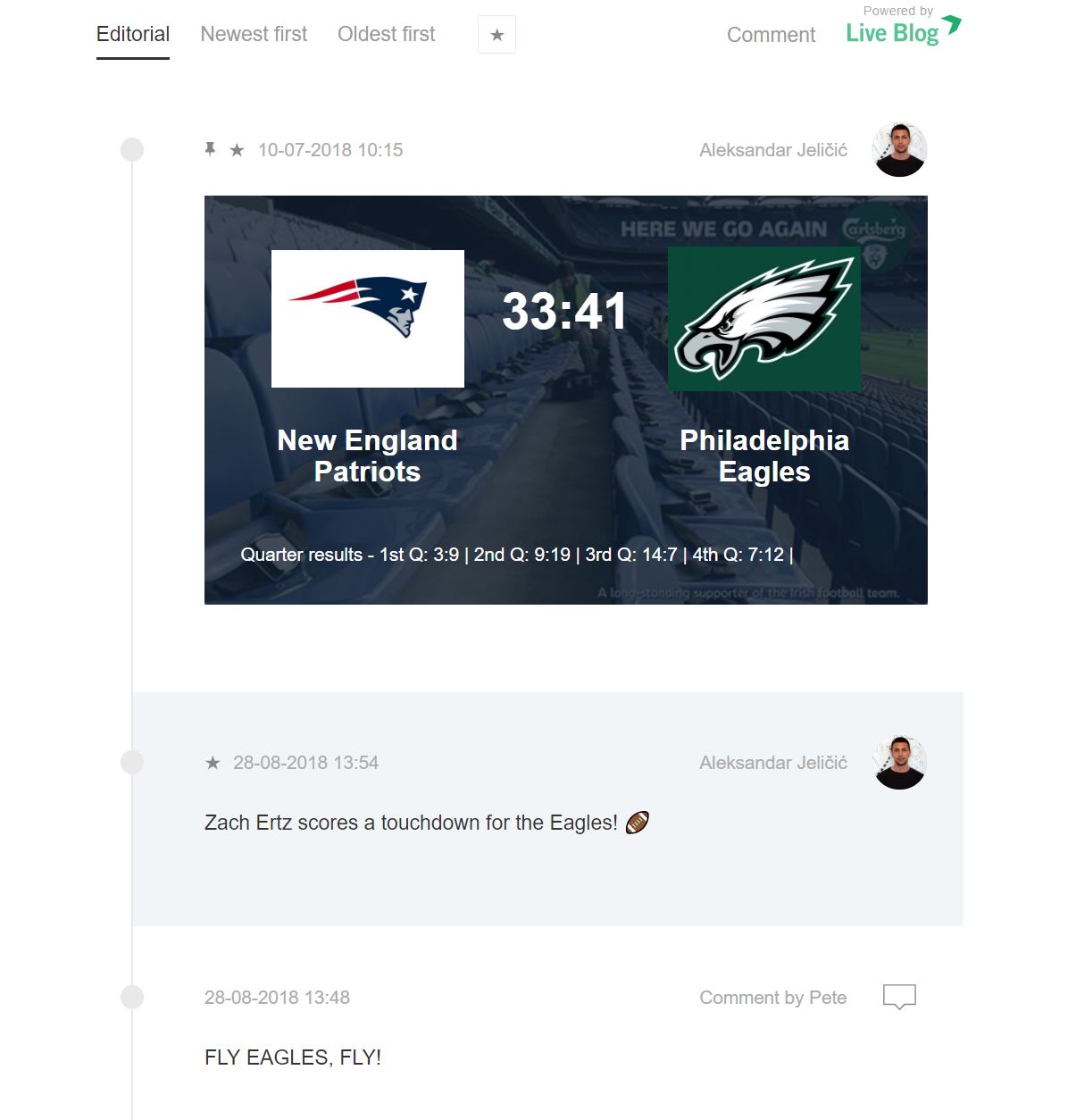
Pin and highlight important posts.
Readers can also choose the order in which they read your coverage with the ‘Editorial’, ‘Newest first’ and ‘Oldest first’ options. The ‘Oldest first’ option may be useful for those reading your blog post-game, as it will give them a comprehensive report on the game as it happened.
Facilitating a second screen experience with Live Blog’s AMP theme
For many live television events, ‘second screen experiences’ have become more and more common for viewers. A second screen experience consists of a person watching an event on TV while also using another device, usually their phone, to discuss or find out additional information about the event they are watching on TV.
Many of your readers will be using your live blog as a space to enjoy a second screen experience when simultaneously watching the game on TV. To make their second screen experience as enjoyable as possible, you may want to consider publishing your live blog under Live Blog’s AMP theme. Offering a much faster loading time on mobile devices than Live Blog’s Classic or Default SEO themes, the AMP theme is designed to offer an enhanced website and live blogging experience for those following your coverage on their phones.
For many, sharing opinions on the latest moment of the game and engaging with fellow fans is an important part of a second screen experience. Live Blog’s user commenting feature works in the AMP theme, meaning that users can engage with your coverage directly from their phones by submitting comments for you to include in your blog.
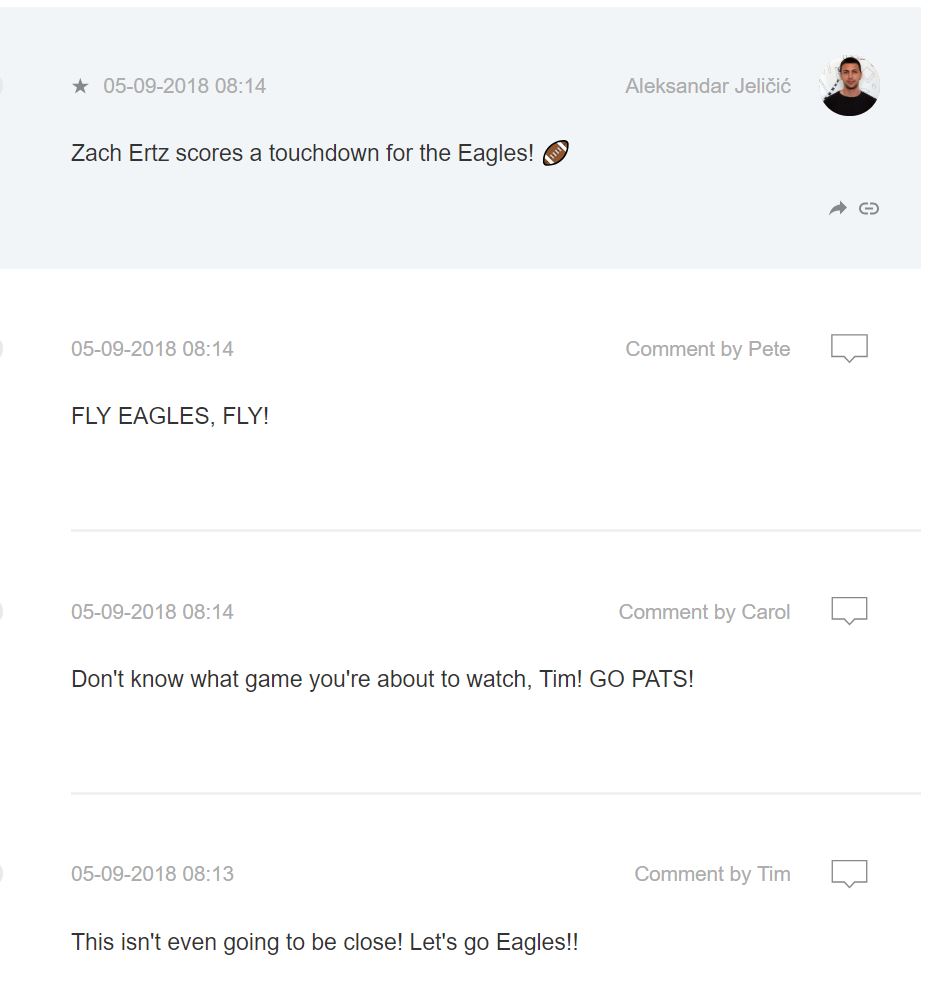
Encourage your readers to engage with your content with the user comment feature.
Both remote and native ads are also configurable in the AMP theme, meaning that readers can engage with your ads on their phones as well as laptops. If you need any help including your AMP-compatible live blog in your AMP page, have a read of our wiki or get in touch with us directly – we’re always happy to help.
This video is made using InVideo.io
July 4, 2018
Live Blogging Pro Tips: Using the Scorecard Feature

Live Blogging Pro Tips: Using the Scorecard Feature
by Thomas Moran | July 2, 2018
Naturally, large football events, like the FIFA World Cup, Champions League and various national matches, see a high demand for online coverage. Covering a match with a live blog offers the opportunity to keep track of every moment, from possession to substitution and formation. But of course, the most pressing updates to keep on top of will be goals scored.
That’s where Live Blog’s Scorecard feature can help. Not only does it allow for key information on the score to be displayed in a visually appealing way, additional points, such as who scored and in what minute of the game, are also easy to include. And the Scorecard feature isn’t limited to just covering football matches either – it’s also a valuable tool for covering other sports such as ice hockey and basketball.
To help you get the most out of Live Blog’s Scorecard feature, we’ve made a short screencast:
If you’re looking for more tips on covering football matches, have a read of our guide on live blogging the FIFA World Cup.
June 25, 2018
7 Tips for Live Blogging Your Running Event

7 Tips for Live Blogging Your Running Event
by Gideon Lehmann | June 25, 2018
From personal experience, I know there’s nothing more exciting than being part of a large running event. From kids high-fiving runners to live music being performed at different points of the race and volunteers handing out water and snacks, there’s always something taking place.
As the organiser of a running event, you’ll want to capture these moments and be able to update your runners with important information. You’ll also need to keep spectators well-informed once the race begins. A live blog will allow you to publish all your updates in one place, ensuring that readers can easily keep up-to-date with the race.
To help you get started, we’ve prepared seven tips that will help you get the most out of live blogging your race day.
This video is made using InVideo.io
#1 Prepare coverage before your running event begins
By having content prepared before the race begins, you’ll have enough time during the event to focus on more pressing updates. Content to create beforehand could include:
- Posts detailing the runners’ profiles
- Interesting facts about the race and its history
- A list of things to see along the race course (monuments, buildings, bridges, etc.)
That way, even during some of the less exciting moments in the race, you’ll always have something to publish.
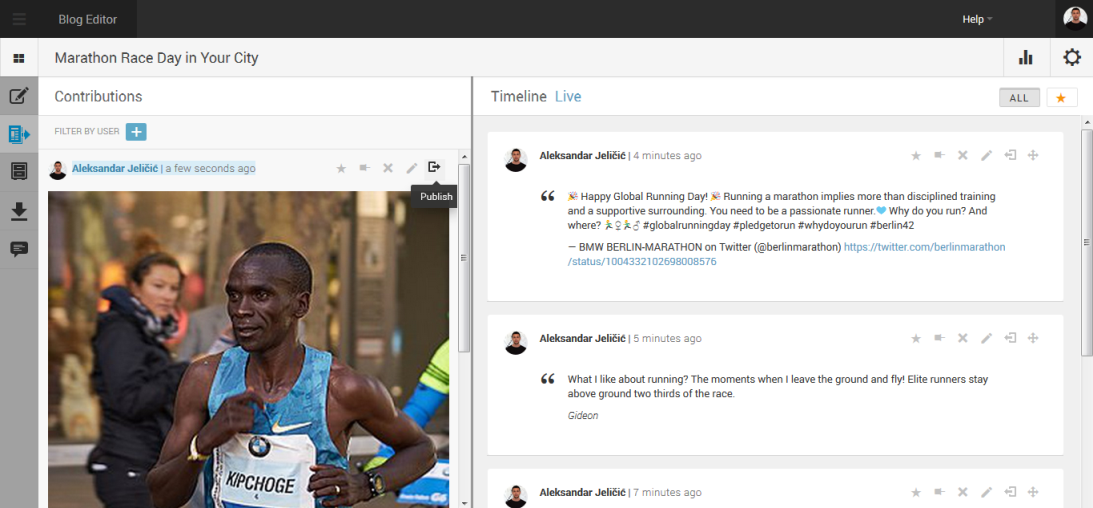
Posts like profiles on talented runners can be prepared well in advance and saved in Live Blog’s Drafts or Contributions sections for when you need them.
#2 Engage your readers
By introducing a social media hashtag, such as #LondonMarathon, before your running event takes place, you’ll be able to find relevant social media posts to include in your live blog. You can further increase reader engagement with your coverage by using Live Blog’s user commenting feature, which allows you to collect, moderate and publish your readers’ comments.
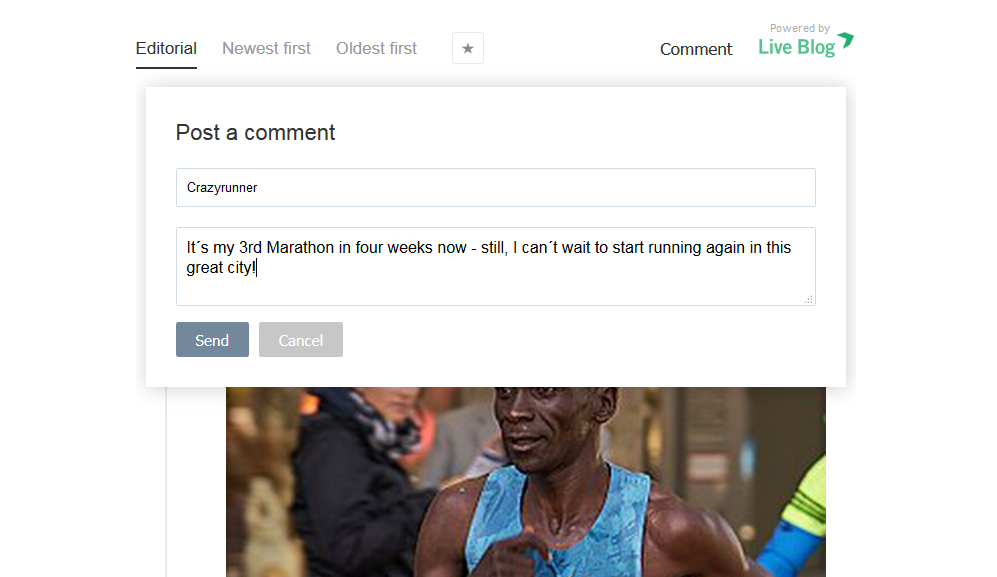
Readers can submit comments to your live coverage.
#3 Organise your live blog’s timeline
Giving your live coverage a clear structure will help your readers keep track of important updates and help latecomers to your coverage get quickly up to speed. Pinning a post will mean that it stays at the very top of your live blog’s timeline, ensuring that it is the first thing a reader sees. Highlighting posts that contain important pieces of information, such as who is leading at the halfway mark, allows for readers who are pressed for time to quickly scan through your live blog.
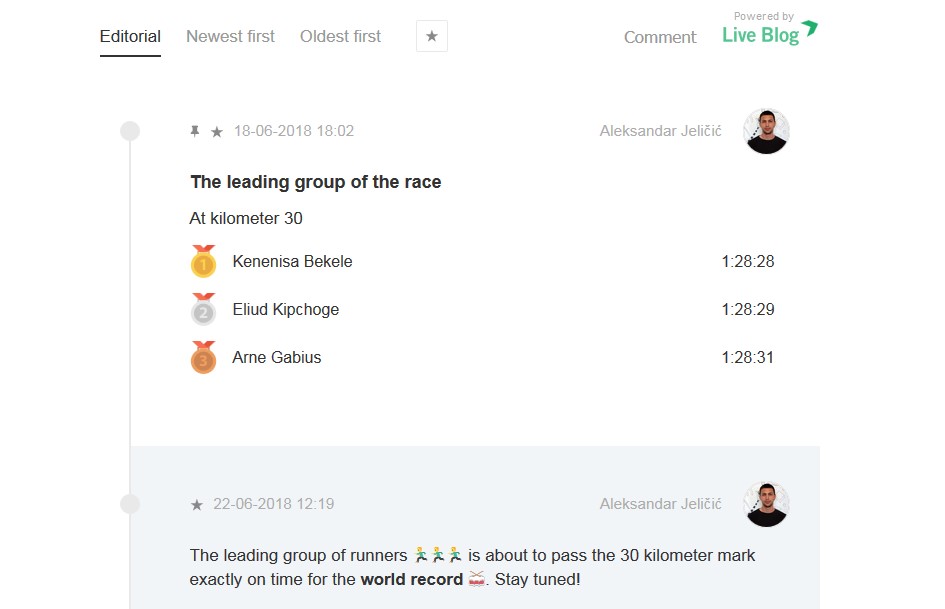
Ensure readers get important information by pinning and highlighting posts.
#4 Make your data stand out
To help you cover a wide variety of events, Live Blog has several post types available, including scorecards, play-by-play commentary and the presentation of statistics in charts and graphs. You don’t even have to be limited to the existing post types either, as it’s easy to create your own with Live Blog’s freetype feature.
When live blogging the International Association of Athletics Federation (IAAF) World Championships in 2017, AthleticsAfrica created a custom post type that allowed them to display small medals next to the winners of a race, which helped to improve the look and feel of their page. The medal post type is now a permanent post type on Live Blog so others can also display the results of the race in this visually appealing way.
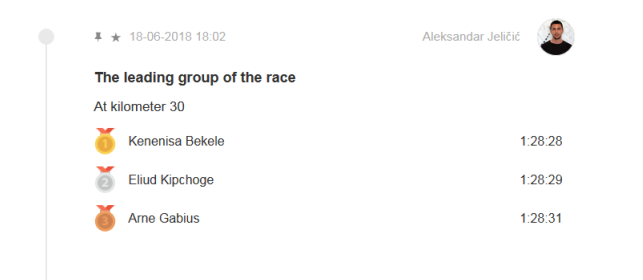
The medal post type is a simple, yet informative, way of displaying the race results.
To show you just how easy it is to create a specific post type for your running event, I created a custom post type using Live Blog’s freetype feature (seen in the image below). I wanted to call attention to some of the important facts and figures of the running event, so I made a post type that would allow me to make certain parts of my text bold and larger.
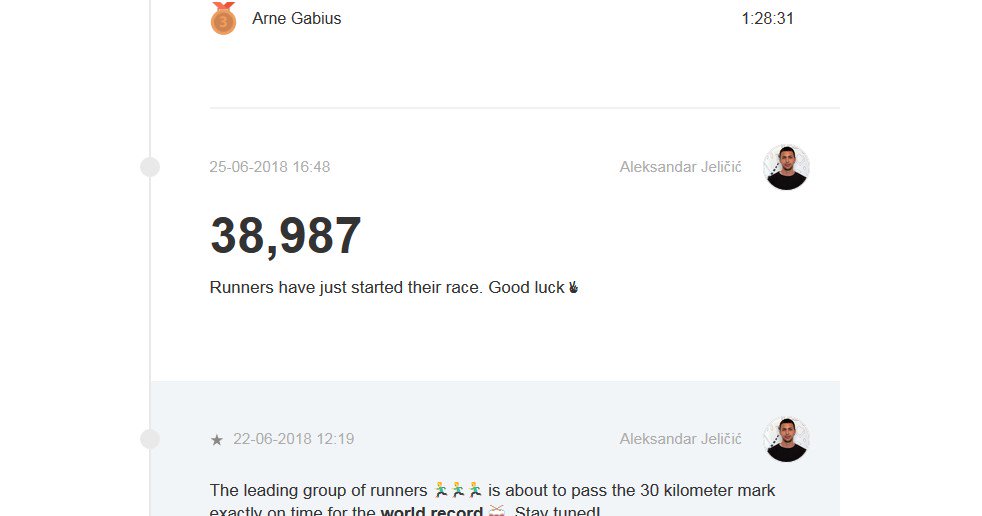
Create your own post types with Live Blog’s freetype feature.
#5 Involve your sponsors
Style your live blog according to your sponsors’ corporate identity and branding. This can be done by featuring their logo prominently on your blog and by including ads for their services in your coverage. You may also want to mention your sponsors in prepared posts that concern key moments in the race – perhaps in the lead up to announcing the winners, or if a new national or world record has been set.
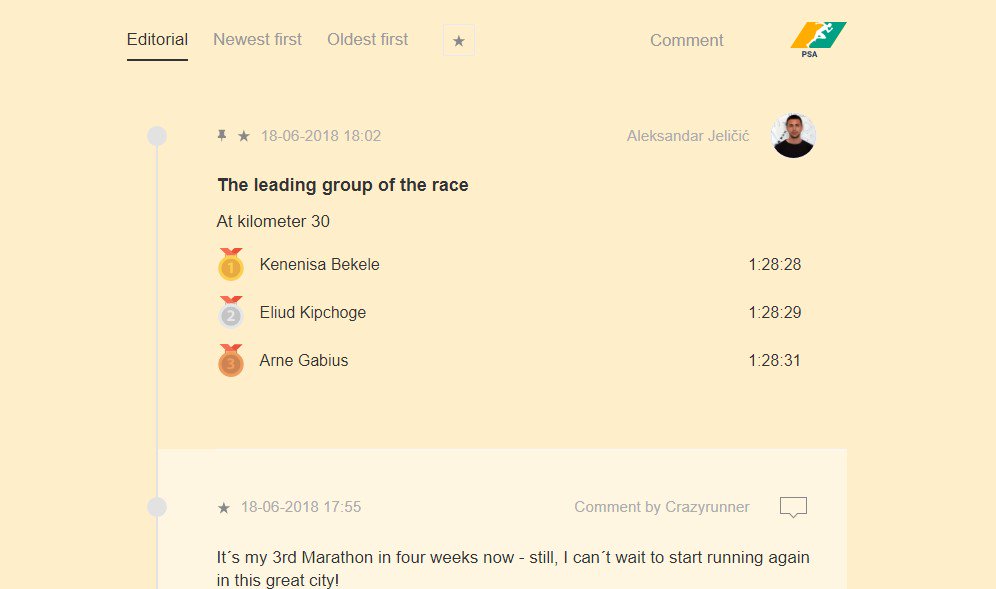
Style your live blog with your sponsor’s colour scheme in mind.
#6 Share customised coverage
To reach a wider audience, consider sharing your live coverage with media partners and sponsors. With Live Blog’s output channels, you can customise the look and feel of your live blog for every outlet that you choose to share it with. This means that the same content can be shared on multiple channels, each with a different design.
#7 Turn your live coverage into a multimedia report
While during the race you’ll want the latest updates to come up first in the reader’s timeline, after the event ends you may want to change the default order so that the reader sees the oldest posts first. By doing so, the reader will be able to read the live blog as a multimedia report on the whole event.
June 18, 2018
Live Blogging Pro Tips: Adding Animated GIFs and Unicode Icons to your Live Blog

Live Blogging Pro Tips: Adding Animated GIFs and Unicode Icons to your Live Blog
by Thomas Moran | June 18, 2018
We recently teamed up with the Eurovision Song Contest to help them create an entertaining live blog that provided music fans with updates and behind-the-scenes content throughout the competition. One way in which Eurovision kept their readers engaged with their live blog was by including animated GIFs and Unicode icons (⛵✈ ☂ ☕ ♫) in their coverage.
To help you enrich your live blog with Unicode icons and animated GIFs, and make your own coverage as eye-catching as Eurovision’s, we’ve created a screencast that shows you just how easy it is to include both in Live Blog.
June 6, 2018
Live Blogging the FIFA World Cup: a Game Plan

Live Blogging the FIFA World Cup: a Game Plan
by Clare Charlesworth | June 06, 2018
From 14 June to 15 July, 32 international football teams will compete in the hopes of being this year’s FIFA World Cup champion. The World Cup is one of the most popular sporting events in the world, with a whopping 1 billion people watching the 2014 final between Argentina and Germany. But naturally, these viewers weren’t just watching on traditional media. An estimated 280 million people watched matches either on a mobile device or online over the course of the event. In FIFA’s words, it’s a clear sign that ‘more and more fans are embracing new technology for sports content’.
One of the technological platforms that many are turning to for online coverage are live blogs, which are an excellent fit for covering sporting events. Have an update on Neymar’s injury? Write a post and have it up on your live blog in seconds. Receiving insider updates from an account on twitter? Grab them and add them with a simple embed code.
Capitalising on the high demand for online coverage of the World Cup, however, can be a daunting task for you and your live blogging team. How best should you present your content so that it is both informative and engaging? How can you make sure that your live blog stands out from other online content on this hugely popular sporting event?
Here are a couple of pointers to help you make the most of your live blog coverage of the World Cup.
#1 Warm up before the match
Match days are sure to be hectic for your blogging team. Having a clear editorial structure in place will save you valuable time when your team begins publishing content. Depending on the scale of your live blogging operation, it might be helpful to manage the different editing privileges that members of your team have. Do you want member A of your team to be able to publish their updates as soon as they finish, but for member B’s posts to be read by an editor first? Establishing this editorial workflow before the match is imperative for staying on top of everything.
Even the most passionate of football fans will begrudgingly admit that not every game is particularly exciting all of the time. At different points in your live blog coverage, such as before the match begins, in the halftime break, or at some slower points in the game, you might struggle to find content and keep your readers engaged. Researching and drafting posts on players and past matches beforehand will mean that you always have enough content to publish throughout your coverage. Live Blog’s editorial workflow structure even allows for potential posts to be stored in your live blog’s contribution section until you are ready to publish.
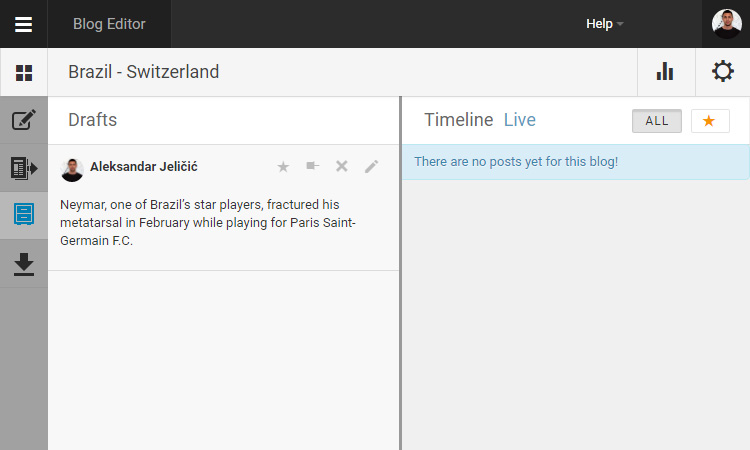
Store potential posts in Live Blog’s contribution section for later use.
#2 Provide a structured reading experience
With so many updates throughout the match, you may be worried about your live blog seeming chaotic at times. A football fan visiting your live blog mid-way through the match might struggle to find key moments of the game without having to read through less important posts first. Consider using a pinning feature to have the most relevant information, such as the score of the match, come up first in your live blog’s timeline. Ensure that other interesting updates, such as a commentary on a goal scored, can be distinguished by highlighting the post.

Highlight important posts to help readers find them easily.
#3 Bring your coverage to life
It can become all too easy for readers to simply gloss over your content if it consists solely of text. Including visual posts, like images and videos of match highlights, will make your live blog’s timeline more dynamic. Additionally, keep an eye on different social media channels for relevant posts to include. With Live Blog, incorporating different forms of multimedia into coverage is simple and intuitive, saving time and effort in high-pressure situations.
Similarly, consider the different methods through which you could represent live data. Conveying complex figures about ball possessions just through text probably won’t resonate as much with readers as a graphic element might. Opt to include charts and percentages that represent the game’s statistics, such as corner kicks, fouls and bookings, visually.
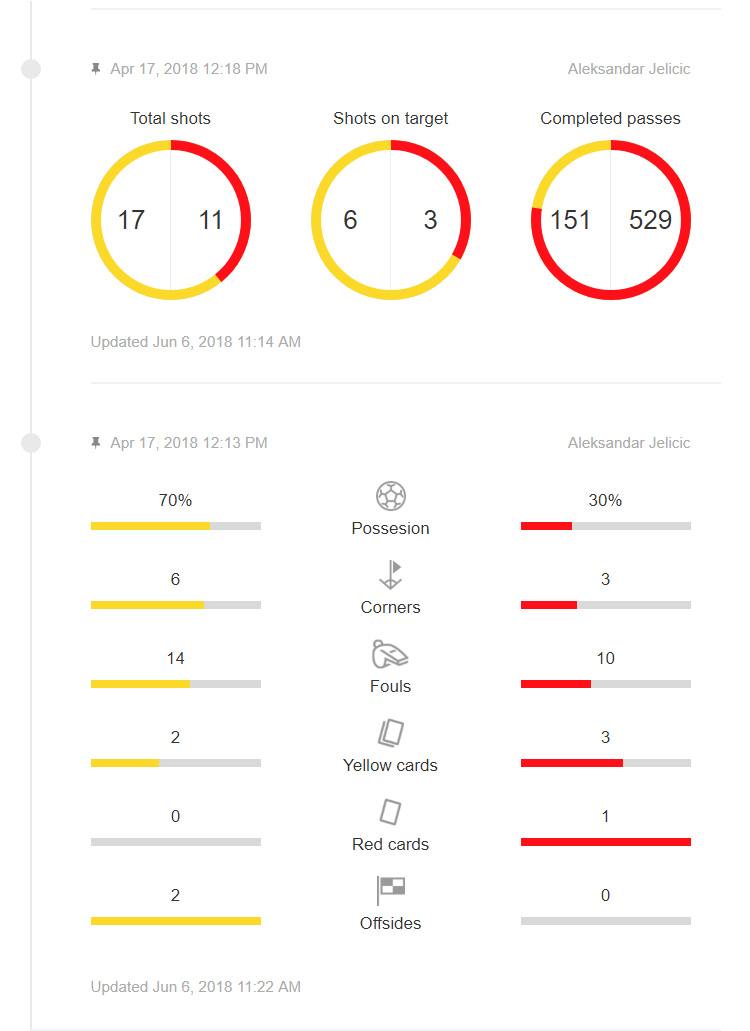
Represent the game’s statistics through charts and graphs.
Including a scorecard is an excellent way to represent the most important information about the match. As described in our tips on how to cover the Champions League, scorecards provide readers with the most up-to-date score of the game in an easily understandable manner. Live Blog’s scorecards are easy to update and can also provide more detailed information, such as who scored and in what minute of the game.
Additionally, engage your readers by including a user comment feature, which allows for editors to incorporate reader comments into your live blog’s timeline. By including this feature, you’ll be able to showcase different opinions on how the match is going while also increasing reader participation with your live blog.

Live Blog’s user commenting feature allows for editors to further engage their readers.
#4 Monetise your live blog
Now that you know how to make your coverage of the World Cup more engaging, why not monetise your live blog by including ads from third-party providers or even ones you’ve made yourself? Get in touch with nearby businesses (a local brewery, for example) and ask them to sponsor your coverage in exchange for the inclusion of their ads in your live blog’s timeline.

Monetise your coverage of the World Cup by including ads in your live blog’s timeline.
May 30, 2018
The Highly-Anticipated Events You Should Live Blog this Summer
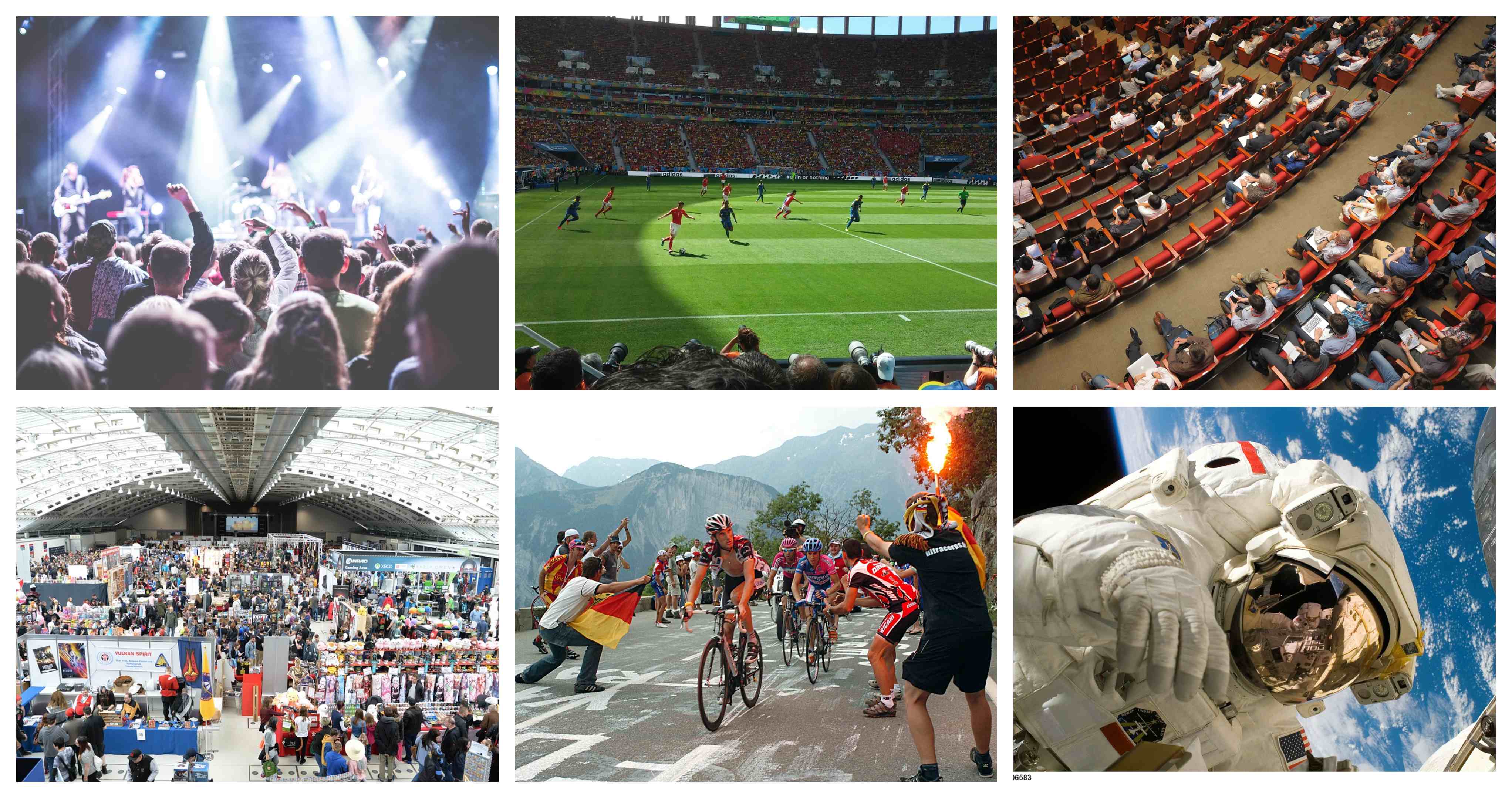
The Highly-Anticipated Events You Should Live Blog this Summer
by Clare Charlesworth | May 30, 2018
From international sporting competitions to decisive elections, there are many highly anticipated events taking place this summer. Some of the events will be over in a flash, making a live blog’s ability to produce real-time updates an asset. Others, such as the Edinburgh Fringe Festival, will take place over several weeks and are perhaps more suited to a ‘slow blog’, which offers updates on a topic over longer periods of time.
To help you keep track of everything going on this summer, we’ve compiled a list of diverse, live-blog-worthy events. If you’d prefer to see this list in a different format, click here to download it as an Excel calendar.
Arts & Culture
Comic-Con (19 – 22 July)
Held in San Diego but followed eagerly by many all over the world, Comic-Con aims to promote an appreciation of comics and pop culture. In recent years, the four-day event has seen attendance exceeding 130,000 and even holds the Guinness Book of World Records as the largest annual comic and pop culture festival.
Edinburgh Fringe Festival (3 – 27 August)
From jazz concerts to stand-up comedy to Rocky Horror performances, there’s no shortage of things to live blog about at the largest performing arts festival in the world.
Eurovision Young Musicians (18, 19 & 23 August)
Part of the Eurovision Family of Events, this music competition consists of performances by young musicians from 18 European countries. If you’re looking for a blueprint, the Eurovision Song Contest recently teamed up with Live Blog to produce an engaging live blog for fans all over the world.
Venice Film Festival (29 August – 8 September)
Established in 1932, this year’s Venice Film Festival will celebrate its 75th edition. Being one of the most prestigious film festivals in the world, many eagerly look forward to finding out who the winners of each category are.
Sports
FIFA World Cup (14 June – 15 July)
Every four years the FIFA World Cup takes place, captivating soccer fans all over the world. As is the case for many other sporting competitions taking place in the summer of 2018, Live Blog’s free sports theme is well-suited to covering the FIFA World Cup, with the theme including play-by-play commentary, scorecards and the production of statistics in both charts and percentages.
2018 Wimbledon Championships (2 – 15 July)
This prestigious tennis championship will take place over the course of two weeks at the beginning of July. The BBC has reported that for last year’s Championships it had 24.1 million stream requests via BBC iPlayer and BBC Sport – just one indication of the large demand for online access to coverage of the tennis matches.
Tour de France (7 – 29 July)
First organised in 1903, this multi-stage race takes its cyclists, and the many viewers who follow passionately from home, all over the French countryside.
Formula One, British Grand Prix (5 – 8 July)
This year will be Silverstone’s 70th anniversary as host of Formula One’s British Grand Prix. To celebrate this milestone, throughout the weekend, Silverstone will also have numerous concerts and other entertainment for racing fans to enjoy.
Athletics World Cup (14 – 15 July)
This year’s Athletics World Cup will be held in London and will see eight of the world’s best athletic nations competing against each other for the Athletics World Cup trophy and the $2 million prize that comes with it. While lasting only two days, the Athletics World Cup will consist of 34 track and field events with 102 individual medals also being up for grabs.
European Championships (2 – 12 August)
This will be the first ever European Championships: a multi-sporting event held in both Glasgow and Berlin over eleven days. Organisers expect there is a potential television audience of 1.03 billion people, with additional millions looking for other digital platforms to receive updates.
18th Asian Games (18 August – 2 September)
Also known as the Asiad, the Asian Games is the second largest multi-sport competition after the Olympics. Alongside more “typical” sports, this year’s competition will see eSports being played for the first time, with plans for it to become an official medal sport at the 19th Asian Games in 2022.
Political Events
Summits
44th G7 Summit (8 – 9 June)
To be held in Canada this year, the G7 Summit brings together world leaders from France, Germany, Japan, Italy, the UK, the US and Canada to discuss important issues currently at play in the world.
US – North Korea Summit in Singapore (12 June)
President Donald Trump and the North Korean leader, Kim Jong-un, are set to meet in Singapore for a historic summit on 12 June. Since the details of this meeting seem to change every day, the summit is well suited to live blog coverage as they offer bloggers a simple, fast updating tool, and readers an easy-to-follow stream of information concerning an important event.
Elections
There are many elections scheduled to take place this summer, the speculated outcomes of which change almost daily. Due to the unpredictable nature of these elections and the ever-changing circumstances surrounding them, live blogs are an ideal match for coverage. Live blogs are able to offer readers real-time updates as the results become available through a wide range of multimedia, including different infographics showing the results of the elections.
For tips on how to successfully live blog an election, have a read of our blog post.
Some of the many elections taking place include:
- Colombia’s Presidential Election (With the first round on 27 May producing no clear majority, Colombia’s presidential election moves into a runoff with the second round taking place on 17 June.)
- Mexico’s General Election (1 July)
- Pakistan’s General Election (25 July)
- Sweden’s General Election (9 September)
- US 2018 Midterms (6 November)
While taking place in autumn, there’s no need to limit your live blog coverage of the US 2018 Midterms to just election night. Many news organisations have begun to use Live Blog as a slow blog, which allows for coverage of a specific topic over longer periods of time.
Conferences
A conference might not be the first thing that springs to mind when considering what events might suit live blog coverage. However, there are many advantages that come with putting the two together. Covering a conference with a live blog can increase audience participation and social media coverage of your event, and by archiving your blog, you’ll have an easy-to-read, comprehensive document detailing the conference. To find out other ways in which live blogs can be used to cover conferences, be sure to read our post.
With so many different conferences taking place, we’ve whittled it down to a couple focusing on journalism and media that you might find particularly interesting:
The GEN Summit 2018 (30 May – 1 June)
This year’s Global Editors Network (GEN) summit will take place in Lisbon, Portugal, with the overall theme of this widely attended meeting being ‘Towards the Augmented Newsroom’. For a better understanding of the GEN summit, see our interview with GEN CEO, Bertrand Pecquerie.
World News Media Conference (6 – 8 June)
Featuring many different speakers, including prominent publishers, chief editors and CEOs of different media organisations, the World News Media Conference is held annually to discuss the sustainability of the media industry and media freedom. This year’s conference will be held in Estoril, Cascais, Portugal.
Global Media Forum (11 – 13 June)
‘Global inequalities’ is this year’s theme for Deutsche Welle’s Global Media Forum, an international media conference that brings together a wide range of fields including journalism, politics and academia to discuss pertinent issues facing journalism today.
Science
World Science Festival (29 May – 3 June)
Bringing together both the general public and some of the brightest scientific minds, the 11th World Science Festival aims to make science more accessible by taking it out of the lab and placing it into ‘the streets, parks, museums, galleries and premier performing arts venues of New York City and beyond’.
NASA (Launch Window: 31 July – 19 August)
NASA’s Parker Solar Probe is scheduled to be launched this summer. Travelling through the sun’s atmosphere, this will be the closest contact any spacecraft has made with a star.
What events are you planning on live blogging this summer? Let us know by using the hashtag #liveblogthissummer
Click here to download this list as an Excel calendar.
April 25, 2018
Top 6 Tips on How to Live Blog Your Next Conference

Top 6 Tips on How to Live Blog Your Next Conference
by Gideon Lehmann | Apr 25, 2018
Here is the good news before you start: Covering your conference with Live Blog is a natural fit. Expect increased user engagement, great social media coverage and easy event-documentation coming out of it. All things you probably already have to take care of but with Live Blog it will be easy to do with just one tool. And with the tips below, we hope your first post will be even easier.
#1 Choose your target audience
With Live Blog you provide minute-by-minute updates of your event to your audience. Now let’s take a moment to think about your target audiences. Live Blog can perfectly be used for both internal and external communication: people not attending the conference can follow the discussions and keynotes on the conference website and even participate by commenting on the live coverage. But apart from this rather classic use-case, Live Blog can also play a good role in engaging the participants of the conference itself. Screen your Live Blog right into the conference room and notice how the visibility of the key arguments to the participants has a positive effect on the discussion itself.
#2 Build a team
Do you have someone in the team taking care of social media and someone doing press relations or dealing with the website? Here you go! Live Blog will actually save them time to reach their goals and have a better audience engagement and outreach. However, live blogging might be a new tool in your communication toolset and building a live blogging team with clear responsibilities is key to a successful live coverage of your event. No matter if there is only one person taking care of the live reporting, a team or if you decide to turn your conference participants into reporters – make sure to clearly assign your team members to the following roles:
- Who is responsible for the blog as a publication?
- Who can publish to the timeline and who is just contributing?
- Who takes care of the social media coverage and is curating the reader comments?
- Once you’ve done that, your coverage will be a smooth operation and a great success!
#3 Prepare well
Live is live and when things are moving forward time is what matters and you will feel great if you can rely on a well-prepared coverage. Here are some suggestions on what you might typically need:
- Ahead of an event set up your Twitter search (and other social media channels) to monitor relevant accounts and hashtags. You can also prepare your first social media posts based on the results of your research and schedule them to be published during the coverage.
- Prepare posts introducing the speakers of your conference. At the beginning of a session keep it at hand and publish it.
- Store your images in a folder available to everyone
- In case your blog is sponsored by a media partner or other type of sponsor – make sure to set up a branded blog and prepare sponsored posts.
#4 Εngage your audience
Studies show that the likelihood of user engagement significantly rises during live events. As a conference organiser, you know this through tracking the trend of your conference hashtag during your event. Live Blog is your ideal partner here because you can both, highlight the activities in the social media by embedding them into your live coverage and make use of the comments feature of Live Blog, curate incoming user messages as well as make them part of your coverage. Another specific aspect, when using Live Blog for conferences, is that you can screen the Live Blog timeline in real time to the conference participants and make them feel particularly engaged seeing their quotes, tweets or comments appearing “big” on the screen.

M100 conference
#5 Publish internally and externally
A Live Blog is normally used to report to an audience that is not present at an event, in (almost) real time about what exactly is happening there. This way you can engage people who were not able to attend the conference, improve the impact of the conference’s outcome and win new participants for your future events – so far so good. But with a Live Blog, you can also reach out to the participants of a conference directly and highlight the importance of their input by screening it on a big screen. This may even have a moderating effect on ongoing discussions in a conference panel: Live Blog sums up the discussion in a way that helps to avoid endless repetitions of arguments already made and shared.
#6 Archive your blog, document your event
Many conference organisers have to actually document the conference output and impact in order to report to their sponsors or initiators. Live Blog will help you with it and save a lot of time. If you cover a conference with a Live Blog you can archive the blog by saving it with the first post on top, emphasizing certain posts as highlights and pin a summary to it on top of the timeline. This way your live coverage becomes a Multimedia documentation of the event and by making use of the analytics feature of Live Blog you can even prove the impact by tracking and sharing the number of visitors on each and every blog.
Extra tip – Set up sponsored blogs
Live Blog is not only your partner when it comes to live coverages – it will also help you to monetize your efforts. In case you would like to offer an attractive package to your sponsors – Live Blog allows you to create branded versions of a blog. All you need to do is to create a branded output channel and apply the logo and corporate color of your sponsor to your blog. How many sponsors do you have – with Live Blog you can create as many branded versions of the blog as is needed for your business. Happy live blogging!
February 6, 2018
Live Blogging Sports Events Creatively with Live Blog

Live Blogging Sports Events Creatively with Live Blog
with AthleticsAfrica
by Gideon Lehmann | Feb 9, 2018
AthleticsAfrica is a news site that had been covering track and field, road running, cross country, and other related competitive events about Africa or African athletes via its website and a variety of social media channels since July 2004. It has become established as a premier source of news about African athletics, with an average of 80,000 visitors to its website on an average day. During major sporting events, traffic can surge to more than 200,000 daily visitors.
In 2017, AthleticsAfrica used Live Blog for the first time to cover the International Association of Athletics Federation (IAAF) World Championships that ran from 5-13 August in London.

Yomi Omogbeja (far right) with IAAF athletes
Live Blogging Provides a Competitive Advantage
Previously, AthleticsAfrica had used a commercial live blogging platform as well as Twitter timelines, but did not find either solution satisfactory. In particular Yomi Omogbeja, editor in chief of AthleticsAfrica was looking for a live blogging platform that would remain available indefinitely after an event, serving as a kind of archive. But that wasn’t the only reason to choose Sourcefabric’s Live Blog.
“Live blogging adds an extra dimension of live coverage,” said Omogbeja. “As a news organisation you become more competitive by reporting during the event rather than afterward.” Omogbeja added that there were many shares of the Live Blog pages, especially in social media.

AthleticsAfrica’s Live Blog from the IAAF event
AthleticsAfrica started as a hobby during Omogbeja’s university days. The website itself was a spin-off of Mr Omogbeja’s MA in web journalism thesis at the University of Sheffield in 2004. A former student-athlete and track runner himself, Omogbeja engaged two other journalist friends studying in the UK to turn the project into a platform to provide news and information on athletics events that were happening back home in Africa. The three kept their passion project going even after they graduated, moonlighting as journalists in their free time.
In 2005, after a stint at the BBC working as a Web Content Assistant on the CBBC website, Omogbeja decided to to put AthleticsAfrica on a fully professional media footing in terms of its tools and public presentation. AthleticsAfrica won the 2011 Telkom / SABC Highway Africa new media award for journalism innovation in Cape Town, South Africa for its website. Continuing to look for more compelling, digital-native storytelling options, it was a natural choice to add Live Blog to AthleticsAfrica’s portfolio of coverage.
Live Blogging Promotes Engagement
Omogbeja and his team quickly began to make full use of Live Blog’s creative possibilities. During the 10-day IAAF event in London, Omogbeja and his team not only covered the full spectrum of athletics events with Live Blog, from the 20 km race walk to the 100 meter dash, but also spun up brand new post types of their own on the fly using Live Blog’s free type feature. For example, they created a medal free type post that highlighted the winners of gold, silver and bronze medals which was a novel way of presenting the information visually and also improved the look and feel of the pages. A number of readers even made screenshots of the medal free type to reshare as image posts on social media.
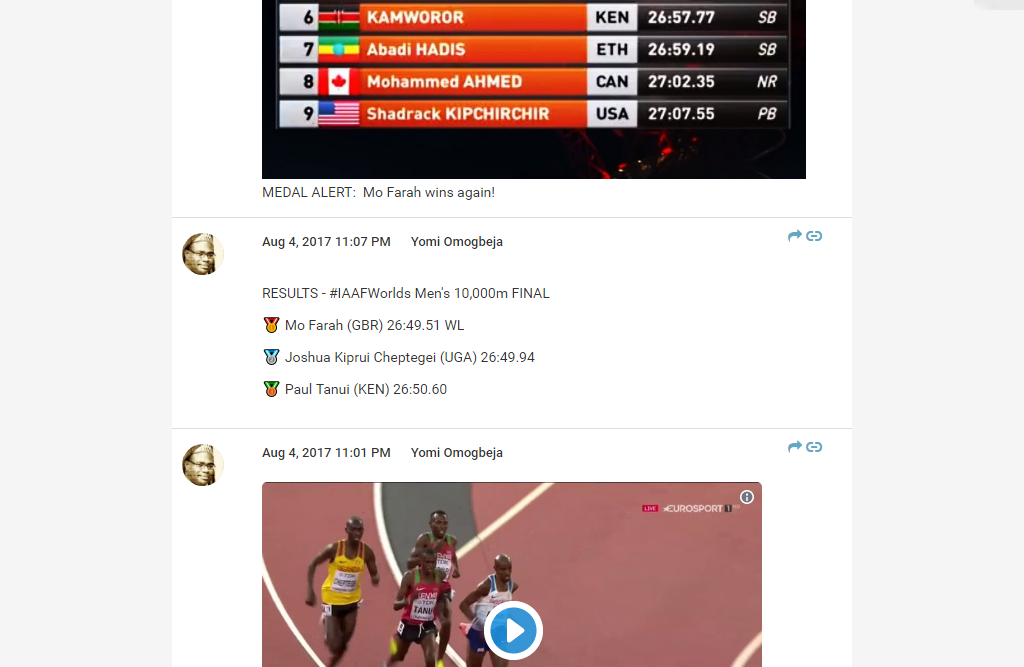
The free type medal in use on AthleticAfrica’s Live Blog
Going forward, AthleticsAfrica aims to add more free type posts for the next major events on the international athletics circuit. One idea would be to create a post for start lists, which would display the name of athlete, lane, country, country flag. “We don’t have play by play commentary, instead we have start lists and live results,” explained Omogbeja.
Find the sports theme alongside with the respective free types on our Github. It´s all free and open source. The free type “medal” is also compatible with the classic theme of Live Blog – just copy and paste it into your Live Blog’s free type manager.
With Live Blog, the field of possibilities is wide open.
January 16, 2018
6 Best Practices from Zeit Online For Live Blogging Breaking News
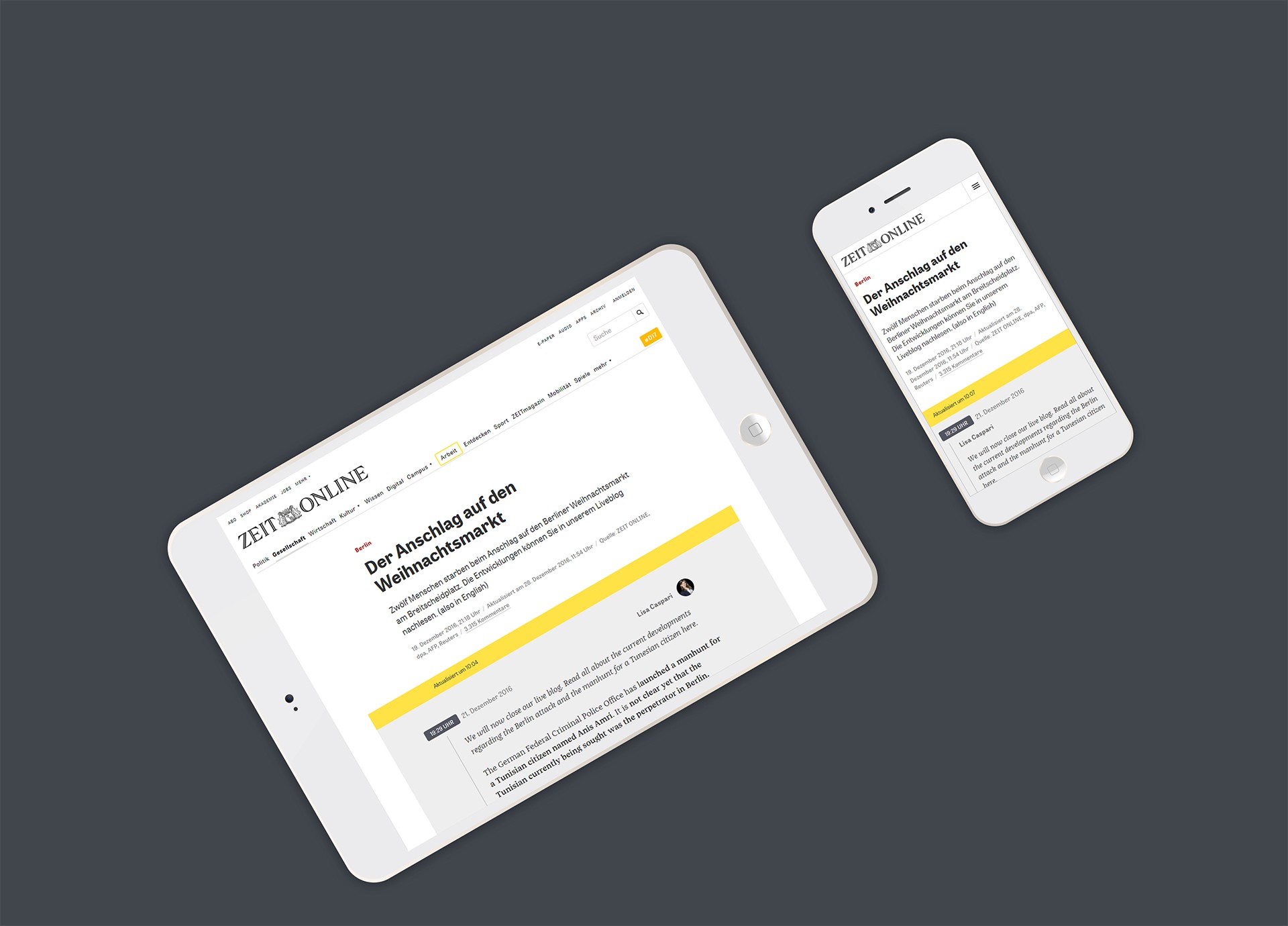
6 Best Practices For Live Blogging Breaking News
from Zeit Online
by Gideon Lehmann | Jan 17, 2018
National elections, terror attacks or fast-changing situations in world affairs: these are all examples of the types of live breaking news stories for which the German news outlet Zeit Online uses Live Blog.
As one of Germany’s largest news organizations, Zeit Online attracts over nine million viewers a month to its website. At times, a substantial amount of this traffic can be driven by its live blog coverage. We recently sat down with Sybille Klormann, lead editor for all live blogging projects, to learn about Zeit Online’s best practices for this dynamic form of real-time coverage.
#1 Choose your coverage strategically
A live blogging tool is ideal for fast and rapid-changing news. However, prior to beginning your live coverage, it’s always important to verify what is actually happening and think about the best way to cover the story.
Once the situation is verified, the local and regional implications must be considered. News providers only have a small window of time to decide if it’s in their editorial interest to cover the story, meaning that they must gauge whether or not there’s enough interest and popularity among their audience.
For example, Zeit Online chose to cover the airport attack in Brussels with a live blog since it was of significant interest. Other examples in which it was necessary to decide quickly whether or not using a live blog were the terror attacks in Manchester or Berlin.
#2 Think in terms of editorial resources
To produce a good live blog requires some advance planning. Some practical questions to consider might include: is there enough staff available at that particular moment and are there reporters on the scene able to provide information, verify facts, as well as submit images and videos?
Another question concerns the linguistic capacity to cover a particular story. Klormann cited examples where a language barrier at first made it difficult to provide adequate live coverage, specifically the 2016 attempted coup in Turkey. In cases like this, Zeit Online needed to rely on secondary sources of information, which made things more difficult than usual, Klormann reported.
#3 Build in communication and collaboration tools
Using established lines of communication is essential for a time-sensitive format like live blogging. Zeit Online’s preferred channel is Slack. Klormann reports the editorial team uses this communication and collaboration tool in order to share information among their reporters and affiliates across the globe. They use this network not only to share information, but also for receiving remote blog contributions as well as to conduct quick and accurate background and fact-checking research. Finally, Live Blog can also be used as a collaboration tool, to let newsroom staff know who’s working on which story at any given moment.
#4 Adapt to the changing media landscape
Because news consumers have taken a much greater interest in live blogs, Klormann observed that the format has also become more professional In the current media environment, live blogs are a go-to form of storytelling. Rather than asking themselves what to cover in this way, news agencies are devoting more energy to how they should structure their live blogs.
In one instance, when Zeit Online covered the battle for Mosul, they experimented with what was referred to as a “slow blog”. Instead of the standard instant-update format, Zeit Online collected and curated various articles as background information using their live blogging tool. They felt that this was a unique and innovative way to consolidate and present all of the articles and updates related to the battle, which took place over a longer period of time.
#5 Take advantage of new technology
Advancements in technology are another point of consideration as they not only make the blogging process faster and simpler, but also provide live blogs with a sleeker appearance and allow for the integration of more types of multimedia. For example, embeds have become much more sophisticated and are a popular way to share a variety of media; social media activity has increased; mobile devices play a larger role in both the consumption and production of news; and the ability for news consumers to interact and engage with the news via a comments section has also become commonplace.
#6 Use professional live blogging software
Zeit Online has been using Live Blog for a number of years. Sybille Klormann also commented that live blogs drive lots of traffic to the site, especially when it comes to breaking news events.
December 6, 2017
The Long Tail of Live Blogs

The Long Tail of Live Blogs
Rank Higher in Search with Live Blog
by Anna Rohleder | Dec 6, 2017
When big news breaks, studies show that readers actively seek out quality information through search ahead of content shared in social media. That’s one reason why having a live blog dedicated to breaking news coverage will boost your site’s profile online. But it’s not limited to the immediate time during and after an event. It turns out that readers go back, again and again, to visit live blog timelines of events in the past.
“Our experience is that live blogs drive lots of traffic to our site,” said Sybille Klormann, an editor at Zeit Online covering politics and economics. “We are often surprised at how many people visit these blogs, especially during elections, but also show a continued interest afterwards.”
The top 10 most-visited live blogs at Zeit Online in the year between July 2016 and July 2017 contain not less than four still getting significant traffic months after the original news event occurred. These live blogs are:
Christmas market attack in Berlin, December 2016
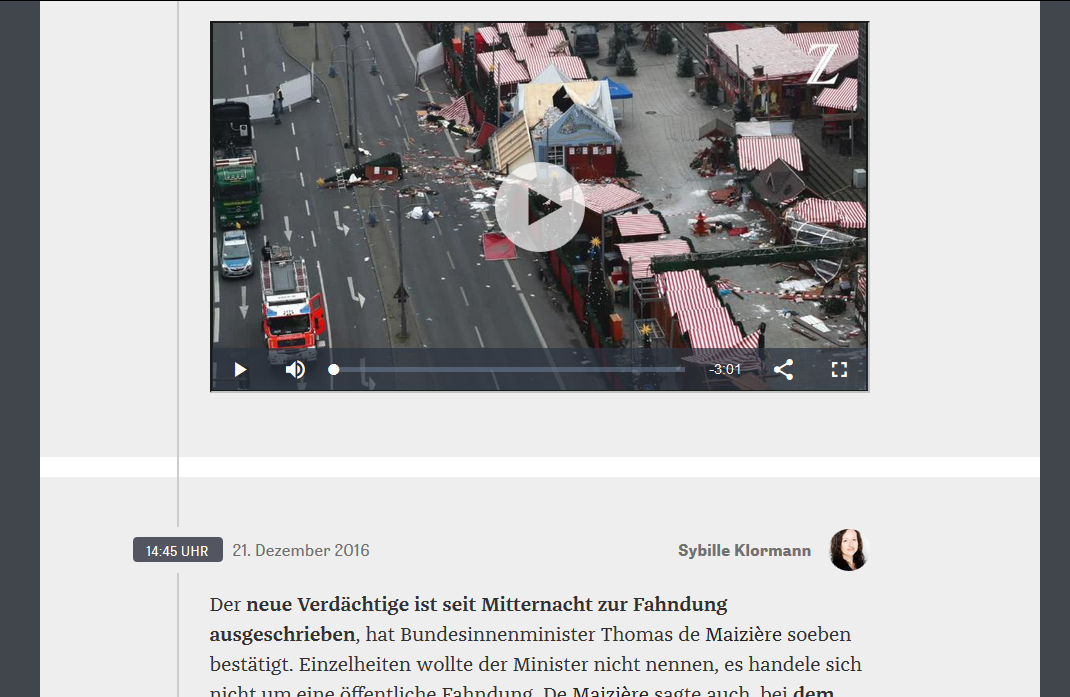
Christmas market attack in Berlin, December 2016
US Presidential election, November 2016
Turkey coup, July 2016
Coverage of Polish government, ongoing since 2015
At dpa, Germany’s leading news agency, online editor Suleyman Artiisik has made a similar observation about the staying power of live blogs. He said:
“Reading a live blog in reverse order, from the end to the beginning, provides an experience of a multimedia news coverage.”
Some news organisations are also using a Live Blog as a “slow blog,” which is a news format that allows publishers and their readers to follow a certain topic over a longer period of time.
For example, the German news agency dpa used this format to keep their readers informed about the refugee crisis as it developed over several months. Meanwhile, the Berlin-based publisher Tagesspiegel has been successful with a slow blog devoted to the local ice hockey team. A substantial fan base now follows the continuous stream of news and updates throughout the whole season. Christian Bigge, head of product development at Tagesspiegel, says:
“With our live blogs we manage to get in direct contact with our audience and keep them engaged for a long period of time.”
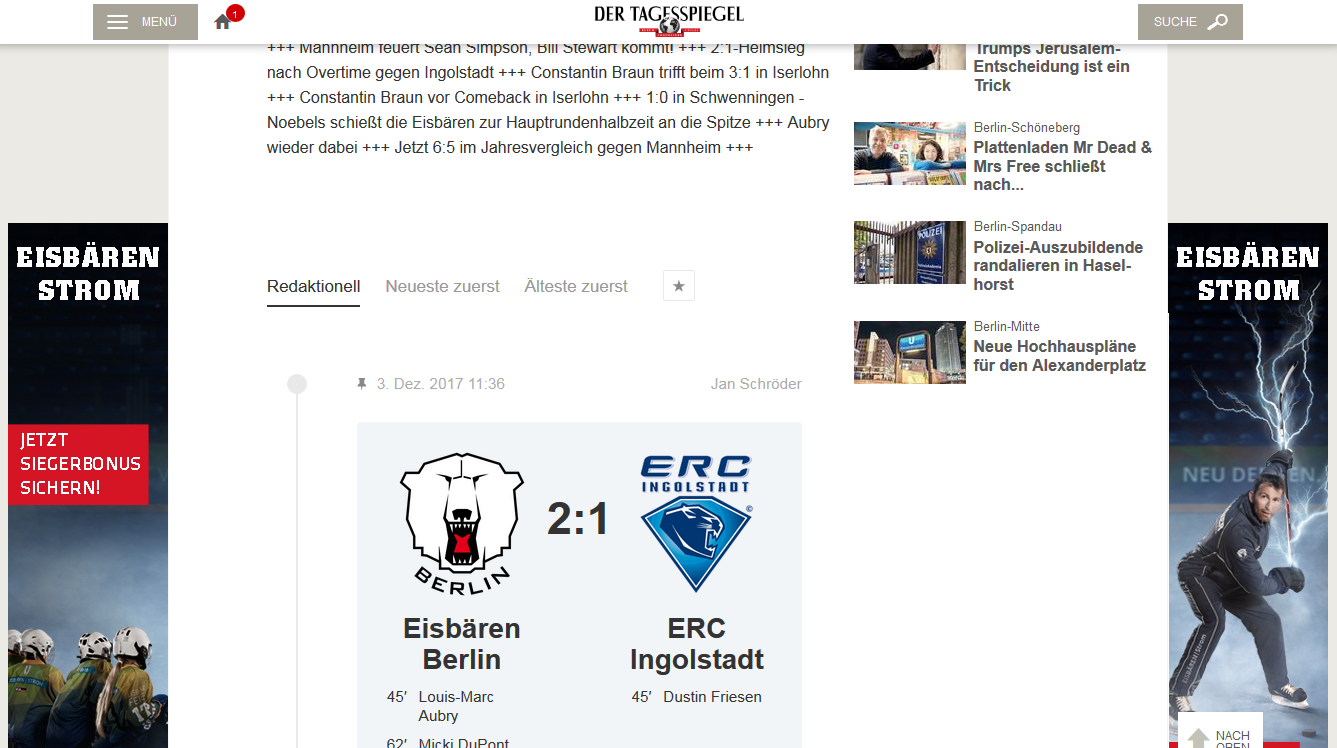
Tagesspiegel’s blog devoted to the local ice hockey team
All of those factors are reason enough for publishers and news outlets to make more use of live blogs. Now Sourcefabric is adding a new feature to its live blogging platform that will give publishers an additional SEO boost. Gideon Lehmann, Live Blog product manager, puts it this way:
“Don’t hide your live content any longer behind an iframe. The new Live Blog 3 SEO Default Theme allows you to produce your Live Blog content in a way that it can be directly injected into your articles and make it appear as what it actually is (to both your readers and search engines): your very own content!”
With this technology, live blog content will become more visible in web searches. Why does this matter? When the text of a live blog post appears as native content to search engines — i.e. it “reads” as part of all the rest of the content on a news organisation’s site — it raises the profile of that news organisation’s coverage in new web searches as well as to its existing audience.
That makes live blogging a win-win strategy for news outlets, especially those publishing in multiple platforms and channels.